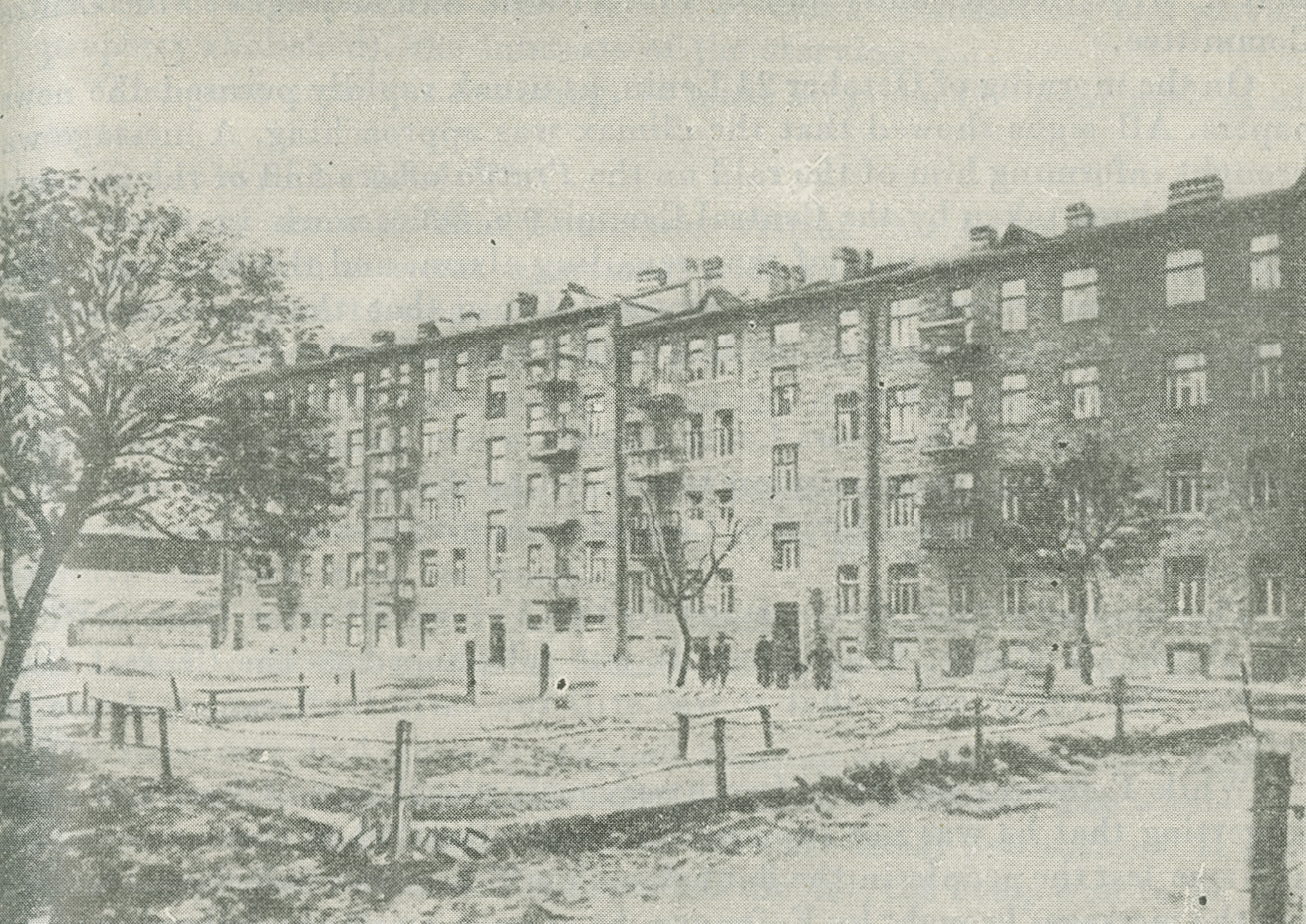
The preparations for the insurrection were directed by Lenin with unflagging energy. At that time Lenin was hiding in the apartment of M. Fofanova, in the Lesnoi District. For reasons of safety the apartment was visited only by Lenin’s wife, Nadezhda Konstantinovna Krupskaya, and his sister, Maria Ilyinichna. Meetings between Lenin and Stalin, and conferences with the Central Committee of the Bolshevik Party, were arranged in other premises. On the instructions of the Central Committee, the Vyborg District Committee of the Party posted Red Guards in plain clothes to keep watch over the house where Lenin lived.
At this apartment Lenin received newspapers, correspondence and messages. The door was opened only in response to a prearranged signal. One evening, Nadezhda Konstantinovna arrived and found a young man at the door. It was Fofanova’s nephew, a university student. Nobody was in the flat except Lenin. He had heard the ring at the door and thinking it was the prearranged signal he went to open the door. On hearing a strange voice, however, he had returned to his room. The student continued to ring. At this moment Nadezhda Konstantinovna arrived.

“I think somebody has got into the flat,” he said in alarm.
“What do you mean?” asked Nadezhda Konstantinovna.
“Well, I rang the bell and heard a man’s voice answer me. I rang again and again, but nobody opened the door.”[1]
The uninvited guest was induced to depart.
Lenin rarely left his hiding place, but one night, rather late, he went out for a walk. He was stopped by a patrol, but finding nothing suspicious about him, they let him go. Lenin walked past the house, fearing to betray his place of hiding.
He returned after a time, but found that the patrol was still where he had left it. As he could not pass into the yard of the house without being observed, he decided to return home another way. He walked to Lanskaya Station and crossed the railway track, but losing his way in the darkness he wandered about all night and arrived home only at daybreak.
Every morning Lenin read a pile of newspapers and immediately after that he wrote articles and comments for Pravda, and messages to the Central Committee.
On the morning of October 24 Lenin, as usual, rapidly perused the newspapers. All signs showed that the climax was approaching. A message was brought informing him of the raid on the Pravda offices and of the measures that had been taken by the Central Committee. Office work in the city finished early that day in view of the prevailing alarm, and the landlady of the apartment, on returning home, informed Lenin that the government was raising the bridges and that she had with great difficulty secured a passage across the river on a boat.
Upon receipt of this news Lenin quickly wrote a message to the Central Committee asking for permission to remove to the Smolny.
“Take this message for the Central Committee and return at once,” he said to Fofanova.[2]
The landlady took the message to the Vyborg District Committee of the Bolshevik Party, from where it was telephoned to the Central Committee. The reply came that it was still too early for Lenin to leave his refuge.
While Fofanova was away Lenin nervously paced up and down his room, forgetting that he was not supposed to walk about when there was nobody at home lest the people in the flat below should hear his footsteps. On reading the message brought by Fofanova, he at once wrote the following letter:
“Comrades,
“I am writing these lines on the evening of the 24th. The situation is critical in the extreme. It is as clear as clear can be that to delay the insurrection now will be absolutely fatal.
“With all the power of conviction at my command I exhort my comrades to realise that everything now hangs by a thread; that we are confronted by problems which cannot be solved by conferences or congresses, even Congresses of Soviets, but exclusively by the people, by the masses, by the struggle of the armed masses.
“The bourgeois onslaught of the Kornilovites and the removal of Verkhovsky show that we cannot afford to wait. We must at all costs, this very evening, this very night, arrest the government, first disarming the cadets (defeating them, if they resist).
“We must not wait! We may lose everything!
“The value of seizing power immediately will be that we shall defend the people (not the congress, but the people, the army and the peasants in the first place) from the Kornilovite government, which has driven out Verkhovsky and has hatched a second Kornilov plot.
“Who must take power?
“That is not important at present. Let the Military Revolutionary Committee take it, or ‘some other body’ which will declare that it will relinquish power only to the true representatives of the interests of the people, the interests of the army (an immediate proposal of peace), the interests of the peasants (the land to be taken immediately and private property abolished), the interests of the starving. . . .
“The government is tottering. It must be given the final push at all costs.
“Delay will be fatal.”[3]
At the very moment that Lenin was writing this letter, Stalin sent a messenger to Lenin’s secret apartment with a letter from the Central Committee inviting him to come to the Smolny.
Fofanova, who had carried Lenin’s letter to the Smolny, returned to the apartment at 9:30 and already found the dispatch rider, Eino Rahja, sitting in Lenin’s room.
For the sake of secrecy and to avoid having an unnecessary witness in the place, Lenin wrote a third message of no particular import and sent Fofanova off with it to the Smolny.
“We shall wait for you until 11 o’clock. If you don’t return by that time, I shall consider myself at liberty to do as I please,” were his parting words to her.[4]
The streetcars had already stopped running and so Fofanova had to walk. The journey there and back took her about two hours. The whole day had been so tense that Lenin forgot to take the usual precautions. It had been arranged that whenever Fofanova left the flat, the lamp was to be left burning, but screened so as not to be seen from the street. When Fofanova returned, however, she found the place in darkness. She groped for a match and lit the lamp. The place was empty. The table was laid for a meal, but there was no sign of Lenin’s overcoat or galoshes. On one of the plates, however, she found the following note:
“I have gone where you did not want me to go. Au revoir, Ilyich.”[5]
The leader of the revolution had hastened to the place where the heart of the insurrection was throbbing—the Smolny.
Changing his clothes, pulling a cap over his head, and concealing his face with a large handkerchief, Lenin, accompanied by the messenger, left the house. The streets were deserted. A lone streetcar was hastening to the depot. Lenin jumped into the car and asked the conductress where it was going.
“You’re a funny chap. Where do you come from? Don’t you know what’s going on in town?” she asked in astonishment.
“No, I don’t,” answered Lenin.
“What sort of a working man are you if you don’t know there’s going to be a revolution? We’re going to kick the bosses out!” the conductress retorted.[6]
Lenin chuckled and eagerly began to tell her how a revolution is made. His companion was on tenterhooks. The car was crowded. Lenin might be recognised and betrayed. Just then the car entered the depot. Lenin and his companion got out and walked. In Shpalernaya Street two mounted cadets overtook them and demanded to see their passes. Rahja entered into an altercation with them, thus giving Lenin the opportunity to walk on ahead. Evidently, the cadets decided that these were two working men who had been on the spree and let them go.
Arrived at the Smolny after midnight they found that it was no easy matter to get in without a pass. They shouldered their way among a group of men who were arguing with the guard. The crowd kept pressing forward and the guards, unable to withstand the pressure, stepped aside.
“Our side always wins,” said Lenin gleefully, pushing his way with the crowd into the Smolny.
Mounting the stairs, he entered a room, sat down by the window, and sent his companion to inform Stalin of his arrival. At this moment a group of Mensheviks entered. Among them Lenin recognised Dan. The group sat down at the table and Dan, puffing and blowing, turned to the man next to him and asked:
“Would you like to have a bite? I have a roll and some sausage.”
As he untied the package Dan glanced at Lenin and then stared at him intently. Evidently he recognised him, for he hastily gathered up the food and hurried out of the room. Lenin laughed heartily. A little later, Stalin, accompanied by a group of comrades, entered.
Lenin was quickly informed of the course of events and Stalin reported to him the latest decisions of the Central Committee. From that moment Lenin permanently took up his quarters in the Smolny: at this crucial turn in the course of history, the leader of the revolution took his place at the helm.
The Smolny, formerly an institute for the education of “ladies of noble birth” and now the headquarters of the General Staff of the proletarian revolution, was entirely in the hands of the Bolsheviks. For over 150 years this building had served as a school for the inculcation of “obedience to God and loyalty to the monarch.” By command of the Empress Elizabeth, the famous architect Bartolomeo Rastrelli—who had arrived in Russia with his father, the sculptor, in 1716—drew up plans for the erection of a convent. This was to have been one of the most magnificent buildings in the world. Rastrelli intended to erect a belfry in the convent 120 metres high. The building was to cost a colossal sum of money. Thousands of serfs were mobilised for the work. The most skilled masons, carpenters and joiners were assembled from all parts of the country. Special brick yards were built to provide the bricks, and numerous villages were ordered to provide the workers for them. Regiments of soldiers were sent to the quarries to hew stone for the building, and cast-iron tiles were ordered at the Siberian and Tula Iron Works.
But the Empress failed to carry out her capricious plans owing to lack of funds. After her death, only a few rubles were left in the Treasury, but her wardrobe was found to contain over 6,000 dresses. Rastrelli was unable to finish the building as he was engaged to build the Winter Palace. In 1764, in the unfinished building of the Smolny convent the “Society for the Education of Young Ladies of Noble Birth” was founded. This was the first state educational establishment to be instituted in Russia for the daughters of the nobility.
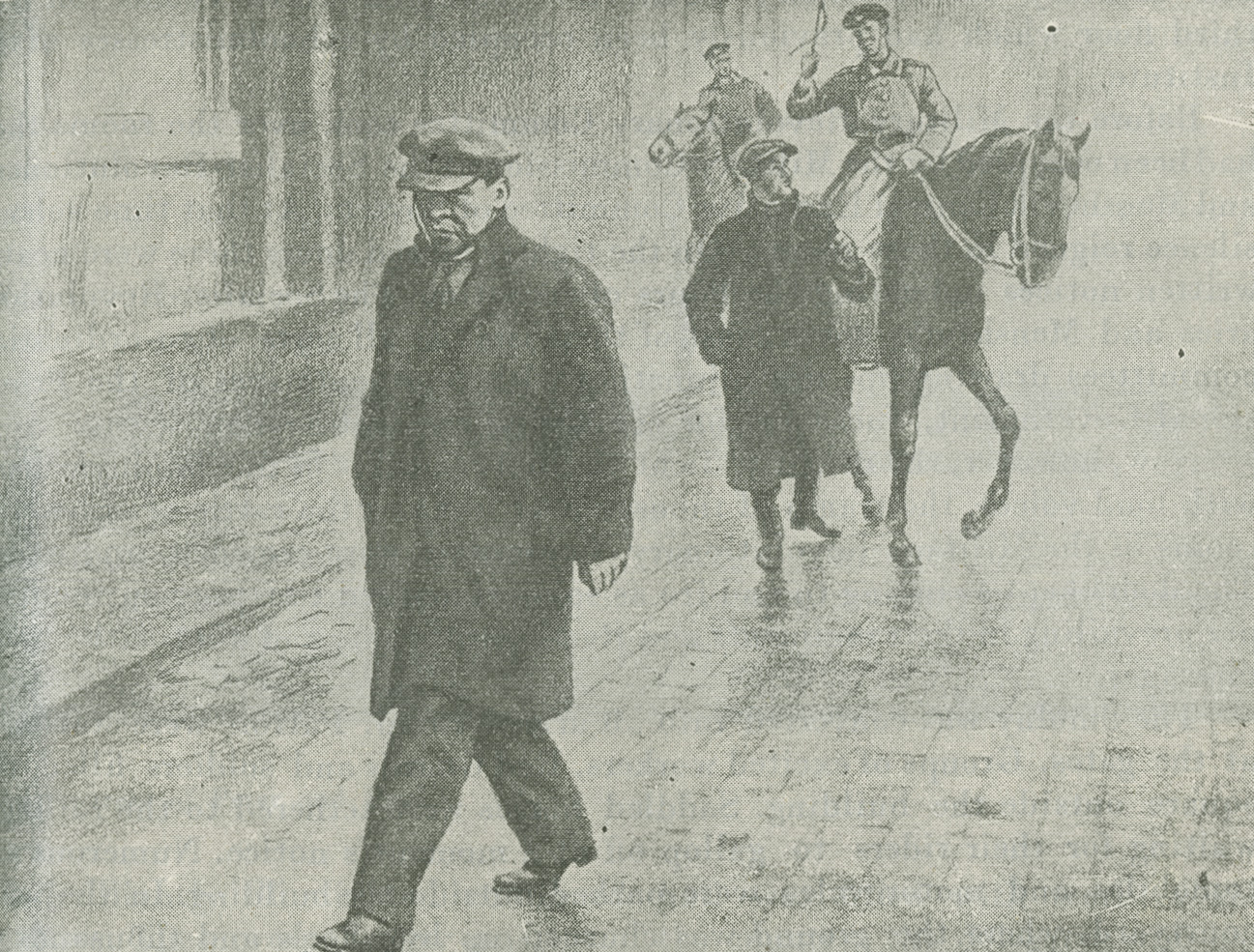
In 1808, a Widows’ Home was built next to the convent under the direction of the well-known architect, Quarenghi. This vast, three-storey building, 200 metres long, with fine columns, lofty vaulted corridors, large, bright rooms, and a splendid columned hall for balls and concerts, was taken over by the Young Ladies’ Institute. The widows were transferred to the convent building, which was at last completed.
The Smolny Institute existed right up to 1917. It was not until August 1917 that the Institute was closed, the inmates distributed among other educational establishments, and the building taken over by the Central Executive Committee of the Soviets and the Petrograd Soviet. From that day onwards the building became the central rallying point of the workers of Petrograd and the soldiers of the garrison. During the Kornilov mutiny the Smolny served as the headquarters for the defence of the capital.
The Bolshevik group occupied room No. 18. Here the representatives of the factories and revolutionary regiments came for advice and guidance. During the October days the Smolny became the centre of the insurrection. The Military Revolutionary Committee occupied three rooms on the third floor which had previously been occupied by schoolmistresses of the Institute.
Before the Military Revolutionary Committee took over the rooms they had been occupied by the Military Commission of the Socialist-Revolutionary and Menshevik Central Executive Committee of Soviets. At that time solemn silence reigned in these rooms. On the tightly closed doors there were neatly written notices indicating the hours of reception. The Socialist-Revolutionaries and Mensheviks spent most of their time at all sorts of co-ordinating committees drawing up, in conjunction with representatives of the Provisional Government, measures for combating the Bolsheviks.
Now, however, the recently silent vaulted corridors of the Smolny echoed with loud voices, the tramp of thousands of feet and the rattle of arms. The rooms of the Military Revolutionary Committee were crowded and noisy. The doors kept swinging to and fro as soldiers arrived to report on the temper prevailing in their regiments and Red Guards came and went with urgent messages.

The Smolny was converted into an armed camp. Patrols were stationed at the gates. Groups of excited workers, Red Guards and soldiers filled the square outside the building. Saddled horses were tethered to the railings, waiting for their riders to gallop off at a moment’s notice. Numerous automobiles and motorcycles were parked outside the building. In the wide courtyard, where the ground was churned up by wheels and thousands of feet, campfires were burning. At the magnificent entrance, at which only recently gilded coaches had drawn up, heavy motor trucks drove up laden with arms. The vaulted corridors echoed with the clatter of machine guns, rifles and cases of cartridges as they were dragged along the floor. And the brilliantly illuminated columned hall was filled with workers and soldiers. These were the new masters of the country, the delegates who had arrived for the Congress of Soviets.
Here, too, in the Smolny, Lenin endorsed the final arrangements for the capture of the Winter Palace—the last stronghold of the Provisional Government.
It was decided to surround the Winter Palace on the line formed by the Zimnaya Kanava, the river Moika up to the Mariinsky Square, and then on to the Neva, gradually drawing in towards the exits of the streets which led to the Palace Square. The best units of the Red Guard, the warship crews and the most revolutionary of the Guards Regiments, viz., the Kexholm, Petrograd, Ismailovsky, Pavlovsky, and Chasseur Regiments, were detailed for this operation, which was planned to be completed by noon on the 25th.
The General Staff of the insurrection had its headquarters in the Fortress of Peter and Paul, where the actual operations for the capture of the Winter Palace were directed.
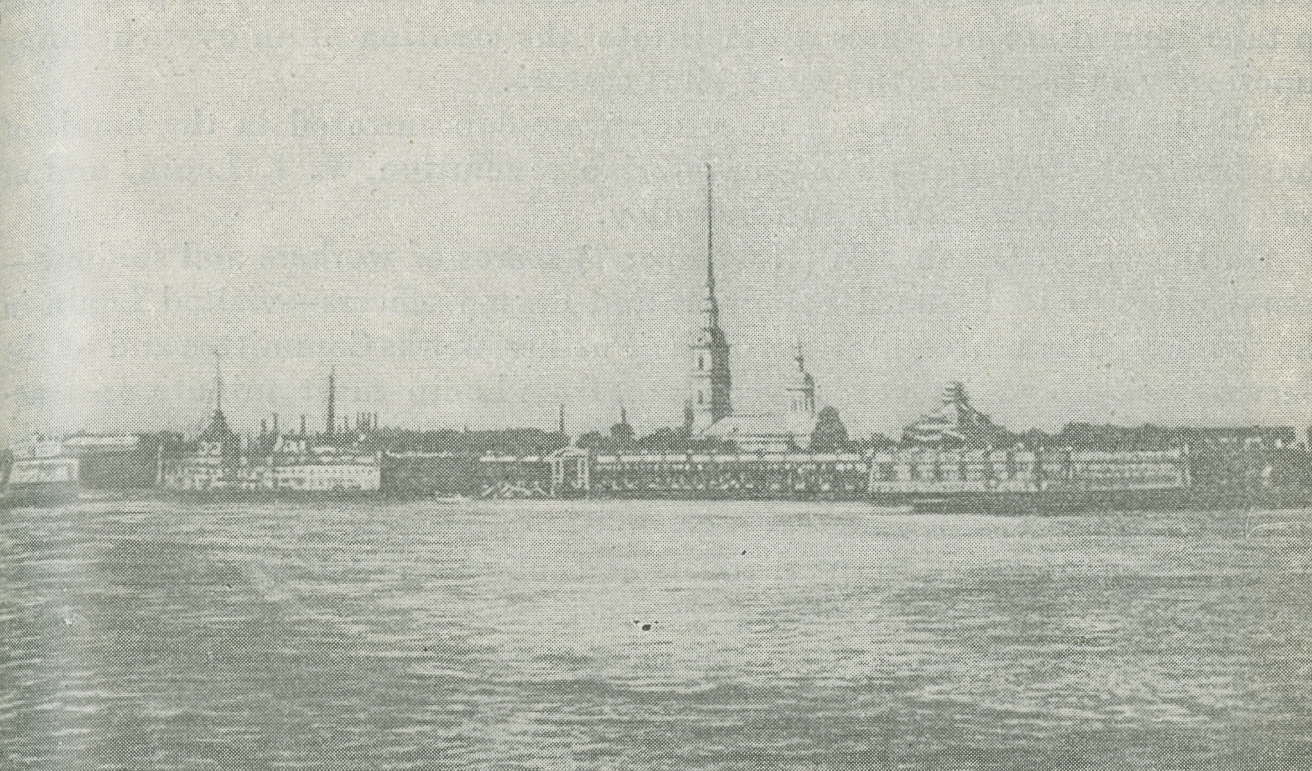
With Lenin’s arrival at the Smolny the Military Revolutionary Committee greatly extended its activities. Jointly with his colleagues, Stalin and Sverdlov, Lenin greatly stimulated the revolutionary initiative and independent activities of the masses. He summoned representatives of the Red Guards, the district and factory organisations and the military units and gave them precise and detailed instructions. He sent representatives of the districts to the members of the Military Revolutionary Committee, urging them to take immediate measures to facilitate the creation of an overwhelming superiority of forces on the most vital sectors.
All the threads of the insurrection were concentrated in the hands of that brilliant strategist of the proletarian revolution, V. I. Lenin, and of his closest disciples, Stalin and Sverdlov.
On the eve of October 25 (November 7) scores of workers and soldiers—commanders of Red Guard Hundreds and liaison officers—visited Lenin in the Smolny. The representatives of the Putilov Works Committee and of the Narvskaya Zastava Soviet received direct from Lenin most minute instructions as to how to organise the swift and complete capture of power in their districts.
Shortly after Lenin’s arrival a group of motor-cyclists left the entrance of the Smolny and sped to the districts and suburbs of Petrograd—they were the harbingers of the insurrection.
Long after midnight, one of these motor-cyclists stopped outside the premises of the Obukhov District Committee of the Bolshevik Party. Here, for three days and nights the District Military Revolutionary Committee had been in continuous session. The messenger handed the commander of the Red Guard a dispatch. It contained the order to commence operations and detailed instructions.
The moment for which the Bolsheviks of the Obukhov Works had been preparing for so long had arrived. Everybody flocked into the street. The streets and avenues were soon thronged with workers streaming towards the works, near which motor trucks were lined up. The pay office of the works was crowded with workers waiting for arms to be served out. The men registered their names as they arrived, formed into units, received rifles, hand grenades and revolvers, got into the trucks and rode off to the city.
The suburbs, i.e., the working-class quarters, rose; the workers hastened to the rallying points where arms were served out.
In the Moskovskaya Zastava District, a district meeting was held in the club rooms of the Skorokhod Shoe Factory on the evening of the 24th, at which a resolution was adopted in favour of immediate armed action. The meeting ended at 2 o’clock next morning and a section of the Red Guards went straight off to place themselves at the disposal of the Military Revolutionary Committee.
At a shed near the weighbridge, opposite the canteen, cartridges were issued. Men emerged from the shed carrying rifles and with machine-gun cartridge belts round their waists and lined up in the yard for roll call. Detachment after detachment passed through the factory gates and marching at a rapid pace disappeared into the night. Similar detachments left the gates of the Rechkin and Siemens-Schuckert Works. The proletariat of the Moskovskaya Zastava District were on the march to fulfil their duty in the October Revolution.
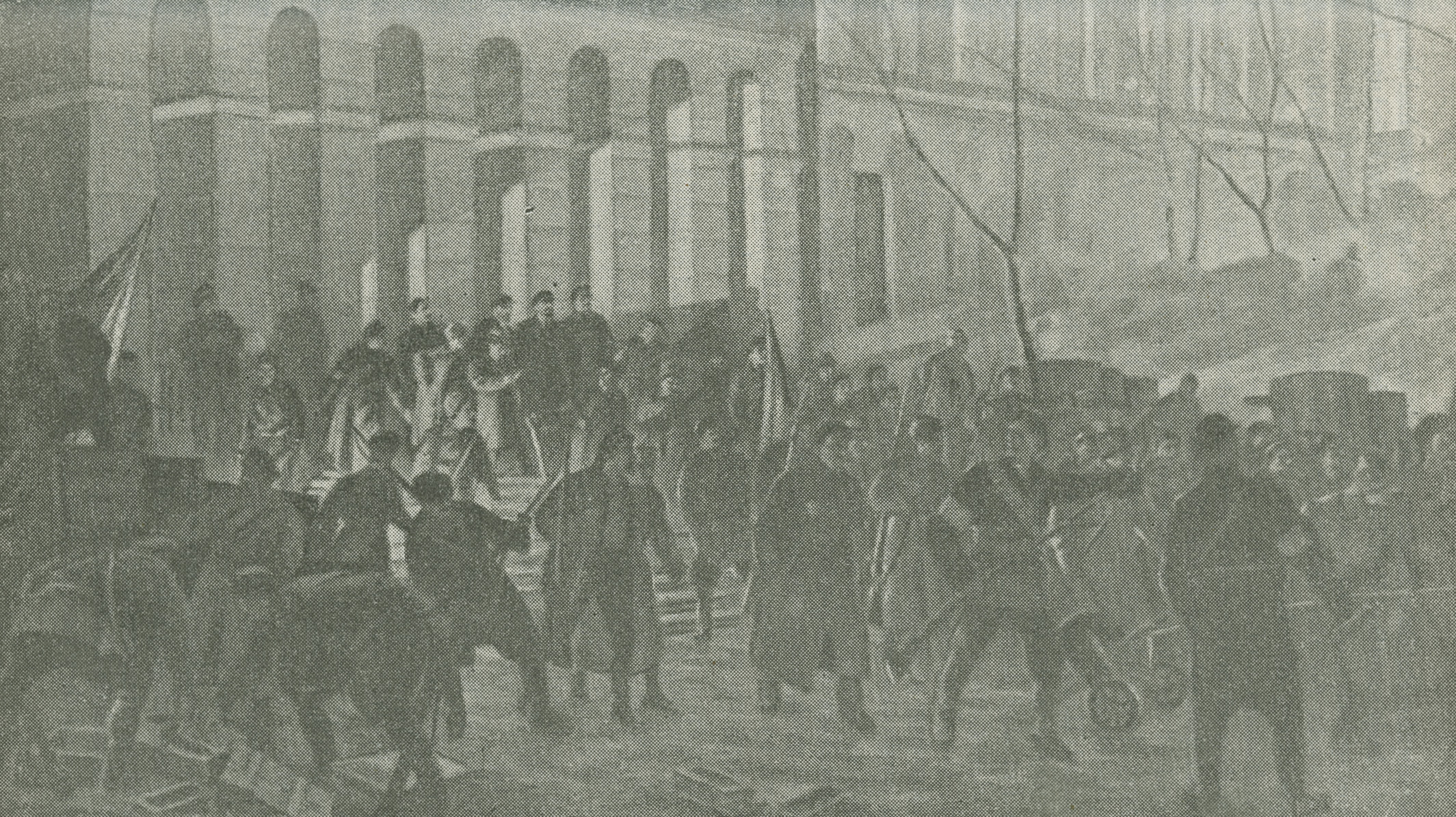
Outside the Putilov Theatre, which only two days before had been the scene of a huge meeting, Red Guard Hundreds were silently lined up. It was all done quietly, quickly, and efficiently. The Red Guard detachments left the works for the District Soviet, and thence to the Smolny. After midnight they marched off to seize the government offices and the railway stations.
Patrols were in the streets throughout the night. The suburbs were deserted. Silence reigned in the Narvskaya Square, broken now and again by the sound of the rapid footsteps of small groups of armed workers hastening along Novosivkovskaya Street to the headquarters of the Soviet.
At the District Party Committees, Military Revolutionary Committees, Red Guard Headquarters and District Soviets the last preparations were hastily being made. In accordance with a prearranged plan, all the members of the Peterhof District Soviet, each accompanied by a small detachment of armed workers of the Red Guard reserve, were detailed to organise feeding centres, the distribution of arms, and the formation of patrols and guard posts. Members of the Putilov Works Committee were sent to assist them, to obtain medical supplies, bandages and automobiles, and to act as liaison officers.
In the Narvskaya Zastava District, the night shifts at the factories remained at work, but each man had his rifle beside him. As soon as the signal was given by the sirens of the Putilov Works, the machines were stopped and the Workers, grasping their rifles, hastened to the prearranged place of assembly.
In the Vyborg District, the District Soviet had established control over the Post and Telegraph Offices as early as the evening of the 24th, and had installed a staff of clerks at the Telegraph Office to take copies of all telegrams. By night time, all transport facilities in the district had been requisitioned. All the motor trucks and passenger cars belonging to the factories in the district had been mobilised and were at the disposal of the Soviet.
The district headquarters of the Red Guard were crowded with workers. Here were assembled the Red Guards from all the factories in the district without exception. There was not enough room at headquarters to hold all the arrivals, and the neighbouring premises of the District Soviet had to be requisitioned. The Metal Works sent a detachment and stated that another had been left at the works, but would be sent at the first telephone call.
A detachment of the Vyborg Red Guards, headed by a Commissar appointed by the District Soviet, occupied the Telegraph Office of the Finland Railway Station. Another occupied the Post Office in Lesnaya Street. The Commissar at the Telegraph Office, a Finnish worker, with an air of great authority, held up telegrams in Danish, Swedish, Finnish and Russian. This display of “linguistic ability” at once won the respect of the girl telegraph operators, and they brought him all telegrams for his perusal.
Shortly after midnight the Red Guards of the Rozhdestvensky District posted pickets in their section. On the way to the Taurida Palace they encountered a Cossack patrol. Shots were exchanged and the Cossacks were scattered. By 1 a.m. the Taurida Palace was occupied.
The representatives of the Izhora Works returned to Kolpino from the Smolny, and that very night armoured cars with machine guns left the works for Petrograd. Two armoured cars were retained for the purpose of patrolling the streets of Kolpino itself. That night a Revolutionary Committee was formed which took over control of the town.
The seizure of the vital points of the city of Petrograd proceeded swiftly and methodically. At 1:25 a.m. a unit consisting of Red Guards from the Vyborg District and the Baltic Shipyards, soldiers of the Kexholm Regiment, and a detachment of sailors occupied the General Post Office, which had already been kept under observation by worker pickets from the Kolomna District. At 2 a.m. two strong mixed detachments captured the Nikolayevsky and Baltic Railway Stations. An attempt at resistance was made at the Telegraph Office at the Nikolayevsky Station, but the railwaymen Red Guards, joining the mixed detachment, cleared the office of counter-revolutionaries and arrested the ringleaders. All the telegraph and telephone exchanges were occupied. A Red Guard telegraph operator was put in charge of the telegraph office. The railway depot and the workshops near the American Bridge were captured and guards posted over them.
Meanwhile other revolutionary detachments captured the Electric Power Station and other important establishments in the city. The workers posted guards at the Central Power Station of the Streetcar Service. The station did not cease to function for a moment, and the streetcar employees were able without interruption to perform their duty of maintaining connections and transporting Red Guards to different parts of the city.
Here and there the counter-revolutionaries tried to check the impetuous advance of the Red Guards. At night the Staff of the Petrograd Military Area made attempts with the aid of cadets to recapture the Petrograd Telegraph Agency and the Central Telegraph Office, which the revolutionaries had occupied that evening. Skirmishes with cadets occurred at some of the bridges. These attempts, however, were thwarted by the revolutionary soldiers and Red Guards.
About 3 a.m. the Pavlovsky Regiment threw a cordon across Millionnaya Street, near the Winter Palace, and held up a car containing cadets from the Winter Palace who were going to seek assistance from the Committee of the Order of the Chevaliers of St. George.
In the same street a patrol of Red Guards and soldiers held up a car in which were Kartashev, the Minister for Public Worship, and A. Galperin, the Director of the Chancellery of the Provisional Government, who were returning home after an all night meeting of the Cabinet. They were arrested and taken to the Smolny.
The Supreme Commissar, Stankevich, was also arrested and taken to a Regimental Committee but was soon released.
The Military Revolutionary Committee sent the following order to the cruiser Aurora:
“To the Commissar of the Military Revolutionary Committee of the Petrograd Soviet of Workers’ and Soldiers’ Deputies on the cruiser Aurora: The Military Revolutionary Committee of the Petrograd Soviet of Workers’ and Soldiers’ Deputies hereby orders you to restore traffic across the Nikolayevsky Bridge with all the means at your command.”[7]
The Aurora had been undergoing repairs in the Franco-Russian Shipyard and had intended to go out on a trial run on October 22 (November 4). The Central Committee of the Baltic Fleet (the Centrobalt), however, had ordered the sailors to remain in Petrograd as the Aurora’s guns might be needed in Petrograd any day.
On the night of the 23rd, the Provisional Government, in preparing to strike its blow at the revolution, ordered the Aurora to put to sea. The sailors however, applied to the Military Revolutionary Committee for instructions. The latter sent the following order:
“Don’t put to sea. Sending Commissar with full instructions.”[8]
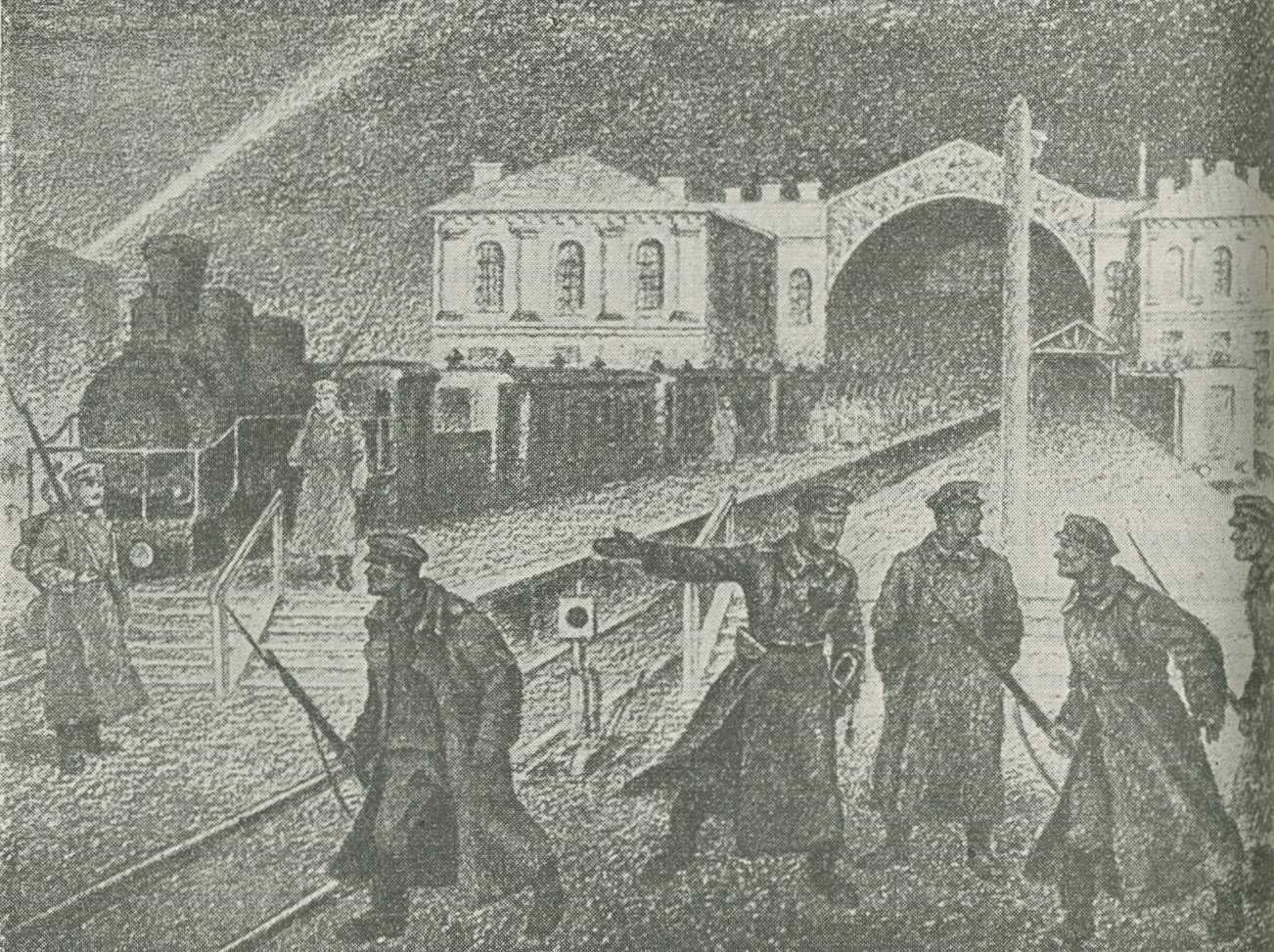
On receiving the order of the Military Revolutionary Committee to occupy the Nikolayevsky Bridge, the Commissar gave the order to get up steam and weigh anchor. While these preparations were being made the Commissar got in touch with the 2nd Baltic Reserve Crew and ordered it to occupy the bridge and restore traffic under cover of the Aurora’s guns. When the cruiser was ready to put off the commander refused to navigate her. “I am afraid I shall run her aground,” he said, in an attempt to avoid taking part in the fight. The Commissar ordered soundings of the fairway of the Neva to be taken, and it was found that the vessel could pass without difficulty. All the officers were forthwith arrested and the order given to weigh anchor. At the very last moment the commander consented to direct the operation. At 3:30 a.m., the Aurora dropped anchor at the bridge. The crew dispersed the cadets who were guarding it and swung the bridge to.
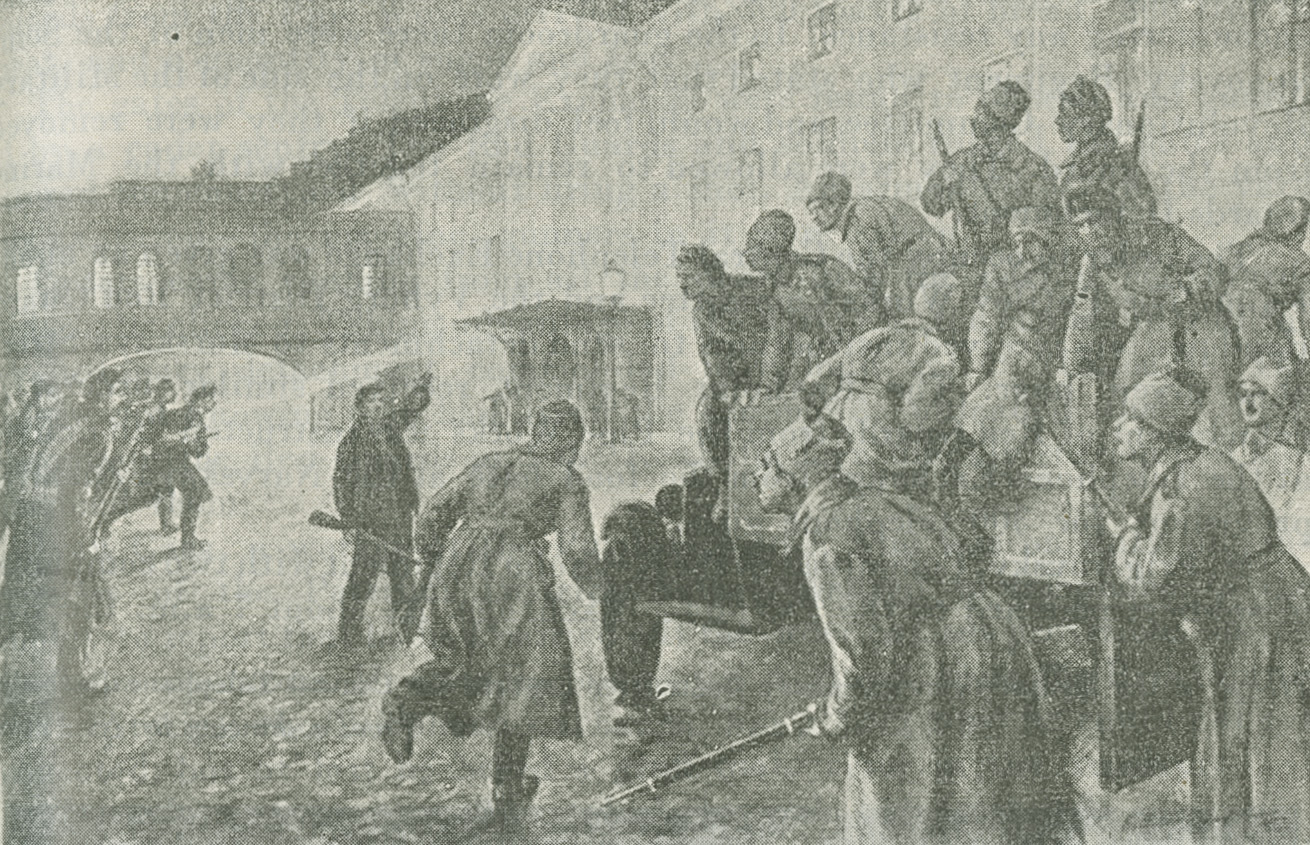
At daybreak the Red Guard of the Kolomna District, in conjunction with the sailors of the Aurora and a company of Marine Guards captured the Hotel Astoria, which had served as a hotel for army officers, and occupied the place after clearing out the officers. A detachment of workers from the Ericson Works captured the Riding School and the Military Technical School in Karavannaya Street.
At 6 a.m. on October 25 (November 7) a detachment of 40 men of the Marine Guards in conjunction with men from the Kexholm Regiment, penetrated the State Bank by way of the guardroom and occupied it without encountering any resistance. In the guardroom there were men of the Semyonovsky Regiment who stated that they were on the side of the Military Revolutionary Committee and would feel disgraced if they were removed from the guard. They were allowed to remain together with the Marine Guards Detachment.
The order to occupy the Central Telephone Exchange was given at about 4 a.m. The Putilov Works Committee and the Vyborg District Red Guard Headquarters received instructions to send detachments to Morskaya Street at a given hour. The Kexholm Regiment received similar orders. A detachment of Red Guards from the Pipe Works was instructed “to deliver at the Telephone Exchange from the food base at the Narvskaya Zastava, provisions for 300 telephone girls.”
M. Prigorovsky, Commissar of the Kexholm Regiment with two companies of soldiers marched to the Telephone Exchange. At about 7 a.m. the Red Guards from the Pipe Works arrived with 300 loaves of bread, 300 tins of meat, and a quantity of sugar and tea.
The gates of the Telephone Exchange were found to be ajar and guarded by a cadet sentry. The Red Guards and soldiers rushed the gates and entered the courtyard without firing a shot. An armoured car in the yard was captured—the machine gunners in it were asleep.

Cadets came running from all the doors into the narrow courtyard. Rifle bolts clicked. Taking advantage of the darkness, the commander of the revolutionary detachment commanded in a loud voice: “Unload!” The cadets, not knowing who had given the command, unloaded their rifles, whereupon the Red Guards and the Kexholm men quickly surrounded and disarmed them.
Ivan Gaza, a worker at the Putilov Works, who was on duty on the premises of the Peterhof District Soviet, wanted to telephone to the Smolny to report that he had carried out the order to issue provisions for the telephone operators. He rang up just at the moment when the Red Guards were capturing the Telephone Exchange. For a long time he could not get connected, but at last he heard a gruff male voice in the receiver:
“I can’t connect you. The telephone girl has fainted.”
As soon as the Telephone Exchange was captured the telephones of the Winter Palace and the Petrograd Military Area Headquarters were disconnected. This greatly hindered the government and Military Area Headquarters in maintaining communications with their troops and governing bodies. They were compelled to use dispatch riders in automobiles, but even this means of communication was soon interrupted by patrols of Red Guards and revolutionary troops.
By the morning the sailors and Red Guards had captured the last remaining section of the Palace Bridge abutting on the Winter Palace. That morning Kerensky, in a state of alarm, entered in his diary: “The Palace Bridge (under the windows of my rooms) has been occupied by Bolshevik sailor pickets.”[9]
At 8 a.m. the revolutionary troops and workers from the Moskovskaya Zastava gained complete control of the Warsaw Railway Station.
Thus, step by step, the detachments of Red Guards, sailors and soldiers, captured the vital centres and the most important tactical points in the capital. Every step of progress was reported to the Smolny. Every 10 or 15 minutes the Military Revolutionary Committee received news of the successful achievement of their objectives by the revolutionary forces.
[1] N. K. Krupskaya, Memories of Lenin, Eng. ed., Vol. II, p. 242.
[2] M. V. Fofanova, “Lenin’s Last Secret Lodgings,” Materials of the Secretariat of the Head Editorial Board of The History of the Civil War, Fund of Vol. II of “H.C.W.”
[3] V. I. Lenin, “A Letter to the Members of the Central Committee,” Collected Works, Eng. ed., Vol. XXI, Book II, p. 144-45.
[4] M. V. Fofanova, “Lenin’s Last Secret Lodgings,” Materials of the Secretariat of the Head Editorial Board of The History of the Civil War, Fund of Vol. II of “H.C.W.”
[5] N. K. Krupskaya, Memories of Lenin, Russ. ed., Vol. III, Party Publishers, Moscow, 1934, p. 8.
[6] E. Rahja, “My Meetings with Lenin Before and After the October Days,” Materials of the Secretariat of the Head Editorial Board of The History of the Civil War, Fund of Vol. II of “H.C.W.”
[7] Materials of the Secretariat of the Head Editorial Board of The History of the Civil War, Fund of Vol. II of “H.C.W.”
[8] Ibid.
[9] A. F. Kerensky, From Afar, Compendium of Articles 1920-1921, Paris, 1922, p. 203.
Previous: At Counter-revolutionary Headquarters
Next: The Flight of Kerensky